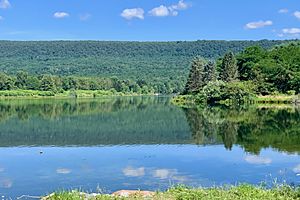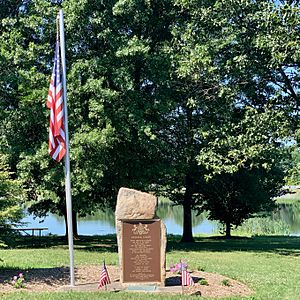Leaser Lake facts for kids
Quick facts for kids Leaser Lake |
|
|---|---|
 |
|
| Location | 8502 Pleasure Court New Tripoli, PA 18066 Lehigh County, Pennsylvania |
| Coordinates | 40°40′07″N 75°50′05″W / 40.66861°N 75.83472°W |
| Type | Artificial Lake |
| Primary inflows | Jacksonville Branch of the Ontelaunee Creek |
| Primary outflows | Sinking Creek |
| Basin countries | United States |
| Surface area | 117 acres (47 ha) |
| Max. depth | 45 ft (14 m) |
| References | GeoNames |
Leaser Lake is a lake made by people, located near Jacksonville in Lynn Township, Lehigh County, Pennsylvania. It's the only lake in Lehigh County. The state of Pennsylvania owns this lake. The Pennsylvania Fish and Boat Commission (PFBC) takes care of it.
The lake was built for fun activities like fishing and boating. It opened to the public in 1971. Leaser Lake is part of a large 540-acre park. The PFBC and Lehigh County share ownership of this park.
Leaser Lake covers about 117 acres, which is like 88 football fields! It is also 45 feet deep at its deepest point. The lake was created by building a dam across the Jacksonville Branch of the Ontelaunee Creek. This creek flows into Maiden Creek. The dam is a big earth wall, about 430 feet long and 53 feet high.
Discovering Leaser Lake's Past
Leaser Lake is named after an American hero, Frederick Leaser. He was important during the Revolutionary War. In September 1777, the famous Liberty Bell was moved from Philadelphia. This was done to keep it safe from the British army.
During its journey to Allentown, the wagon carrying the bell broke down. Frederick Leaser helped by letting them transfer the bell to his wagon. He then helped carry it to Zion Reformed Church in Allentown. Frederick Leaser lived in what is now Lynn Township.
Keeping the Dam Strong
The dam at Leaser Lake has had some challenges over the years. Since it was first filled, there have been issues with water leaking through it. This is called "seepage."
In 1991, the PFBC had to drain the lake. They did this to fix the dam. However, those repairs were not enough. In 1999, the lake had to be lowered by 20 feet. This was done to prevent the dam from failing.
Later, in 2008 and 2009, the lake was drained again. This time, the dam and its spillway were rebuilt. A spillway is like a controlled overflow area for water. Soon after the lake reopened, more seepage was found. This new leak was not in the area that was just rebuilt.
In September 2014, the lake was lowered by 20 feet again. This allowed for more repairs to be made. Finally, in Spring 2015, the dam repairs were finished. For the first time since 1991, Leaser Lake was completely full of water!
Fish You Can Catch at Leaser Lake
Leaser Lake is a great place for fishing. Here are some of the main types of fish you might find there:



